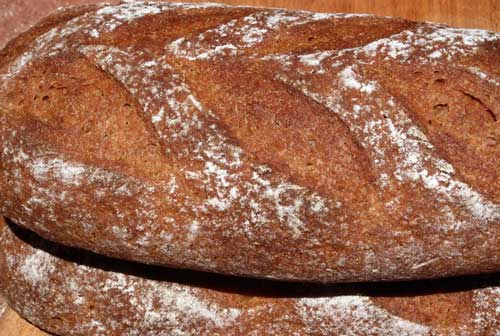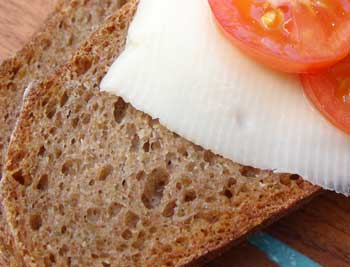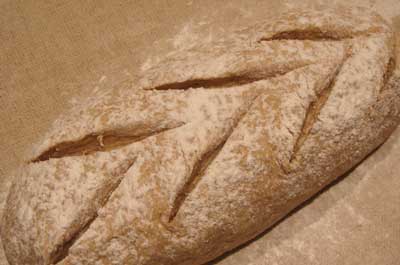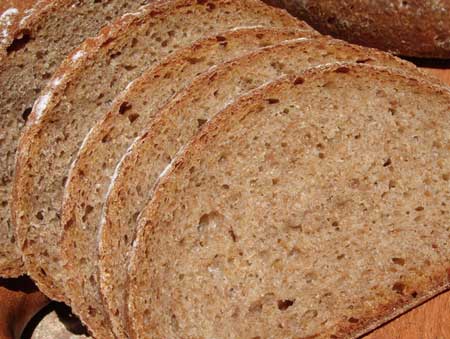Ulrike of Küchenlatein set the task for BBD #3: bread leavened exclusively with sourdough, preferably rye. The sourdough part did not make me nervous, but the rye part did. Rye bread and I do not exactly have a long history together.
For one thing, I only recently acquired a taste for it. For another, to be honest, it scares me a little. Other than the wheat family, rye is the only grain that contains gluten, but its gluten is much more fragile than wheat’s. It can, therefore, tolerate less mixing and fermentation. The prospect of a twitchy dough made for a twitchy me. Time to be brave.
To make the rye starter, I took a portion of my regular 100% hydration white starter and fed it with whole rye flour (equal parts flour and water, by weight) for a couple of feedings.
Most of the sourdough rye recipes in my library call for added yeast, but that seemed to be against Ulrike’s rules, so I left the yeast out and had to make some educated guesses, which turned out to be not altogether correct, about how this would affect the fermentation time.
I meant to proof the shaped loaves until the slashes (which I made just after shaping) just started to crack at their ends. But this happened sooner than I anticipated, and my oven was not hot enough to bake them yet, so the loaves overproofed by about 20 minutes. (The proofing time in the recipe reflects what I think it should be, not what I actually did.) They deflated a bit when I transferred them to the peel, and they ended up flatter than what I had hoped for.
Even so, I’m encouraged by the way the bread turned out. It’s dense and flavorful, and easy to slice very thinly for a cheese board or open-faced sandwich. I think making this has taken a little of the edge off my rye anxiety.
Rye and Whole Wheat Sourdough
Yield: 2100 g (4 loaves)
Time:
- Mix/autolyse: 40 minutes
- First fermentation: 1.5 – 2 hours
- Divide/rest/shape: 20 minutes
- Proof: 50 minutes
- Bake: 50 minutes
- Cool: 12 hours or longer (for best results)
Desired dough temperature: 78F
Ingredients:
- 415 g whole rye flour (I used KAF organic pumpernickel)
- 415 g whole wheat flour (I used Whole Foods organic)
- 195 g high-gluten flour (I used KAF Sir Lancelot)
- 391 g ripe 100%-hydration rye starter
- 726 g water at approximately 70F
- 24 g (4 t.) salt
Method:
- Combine the whole wheat and high-gluten flours with 500 g of the water. Mix on low speed until just combined. Allow the dough to rest (autolyse) for 30 minutes.
- Add the salt, starter, rye flour, and remaining water. Mix on low speed until the gluten has reached a low-medium level of development, about 8 minutes. The dough will be sticky and will not clear the sides of the bowl.
- Transfer the dough to a covered, lightly oiled container. Ferment at room temperature (72F – 76F) until the dough has increased to approximately 1.5 times its original volume, about 1.5 – 2 hours.
- Turn the dough onto a lightly floured counter and divide it into 4 pieces of about 525 g each. Shape each piece into a light ball, sprinkle lightly with flour, cover with a towel, and let rest for 15 minutes.
- Shape the dough into blunt-ended batards with a round cross-section. Sprinkle the tops with flour and score in a chevron pattern or leave unscored. Place right-side-up in a floured couche or linen-lined bannetons.
- Slip the couche or bannetons into a large plastic bag and proof at room temperature until the ends of the scores just start to crack, about 50 minutes.
- Meanwhile, preheat the oven, with baking stone, to 500F. You will also need steam during the initial phase of baking, so prepare for this now.
- Transfer the proofed loaves to a semolina-sprinkled peel or parchment paper, and then to the hot stone.
- Once the loaves are in the oven, turn the temperature down to 450F. Bake with steam for 10 minutes, then another 30 minutes without steam. Leave the oven door cracked open a bit during the last 10 minutes of this time to help the loaves dry out. Then turn the oven off and leave the loaves inside, with the door ajar, for another 10 minutes.
- It is essential to allow the bread to cool completely before cutting it, or it will be gummy. It is even better the day after baking.




Wow, lovely bread! I am a huge and long fan of rye.
Tanna, I don’t know why it took me so long to like rye. I really love it now (to eat; I can’t say it’s my favorite – yet – to bake. Do you ever bake rye bread?
Susan,
Very nice web site and I like your breads. I have been following your work at TFL and thought I would see what else you are doing. You have a lot to share.
Eric
Looks great! I just baked two breads for bbd.
Eric, thanks for stopping by. I am a fan of your bread, too, and you are of course an old hand at rye, an inspiration!
Zorra, thanks again for founding bbd. For some reason I can’t access your website to see your latest breads. Hopefully that’s just temporary.
Thanks for your entry. The BBD#03-round up is now online.
I’m so glad that I didn’t read this BEFORE making my rye sourdough! I had no idea that it was supposed to be tricky… (ignorance IS bliss)
How lucky am I that ours turned out!?
And clearly, you didn’t need to be worried at all. Your bread looks beautiful! I really like the slash marks.
-Elizabeth
Pretty loaf…
The slices look appealing. Lovely bread!
Ulrike: Thanks so much for hosting this BBD and giving me a reason to make friends with rye.
Elizabeth: Oops, I really wasn’t trying to scare anyone, just confessing my insecurities. I’m glad yours turned out well!
Tatter: thanks!
Arfi: thanks, one of the things I like about this bread is how easy it is to slice thinly.
I am going to try soon. Your blog inspires and informs. thanks
I had some buckwheat flour on hand, so I used ~200g rye and 200g buckwheat (the rest of the flours I held constant). I also added a tablespoon of malted barley syrup (breads I like from the store often have this ingredient, so I figured, what the hey!) and a cup of crushed walnuts. The bread came out dense, moist (but not gummy), and with a nice spring to the crumb. Delicious!
I was excited to find this recipe, as so many “sourdough” whole wheat breads call for packaged yeast to supplement starter. Thanks, Susan!
Your bread looks great. Must also taste great with some nice cheeses.
hi there,
i have just started baking bread and i must say that i am loving it! my husband loves rye bread so much and since his birthday is around the corner i thought i’d bake him this bread. but yes, this may sound silly but i have no idea how to make the “ripe 100%-hydration rye starter”. lol. i’ve been scrolling up down right left but i couldn’t find a link or recipe for it.
thank you.
Hello,
I made a sourdough starter following yours instructions (whole rye flour). Thank you for sharing. By the 3rd day it was doubled its volume. I used it after 7 days in your ‘rye and whole wheat sourdough’. But something went wrong. The bread came out quite doughy, so I let it longer in the oven, maybe about 1h. And still did not look baked, quite wet in the middle and bottom. It did not keep the shape either, came out a flat bread, ciabatta type. Probably rose too much? My first attempt was a failure and I’d like to understand what went wrong, in order to continue my adventure with the wild yeast. I will really appreciate your help and thank you for your time and explanations. Have a nice day. Best regards, Paula
Hello! I cannot wait to try this recipe! But what do you mean by ripe starter? I always make your Norwich sourdough, and I also don’t know exactly what you mean by mature starter either haha what is the difference?
Thank you!